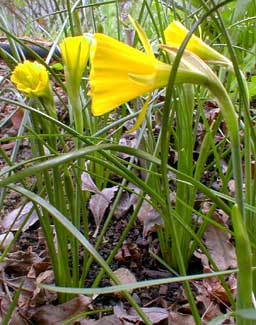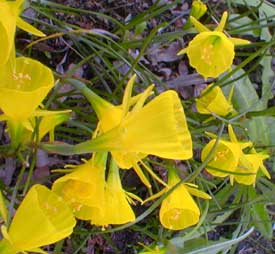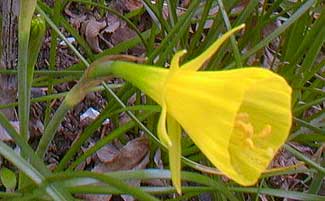
"Golden Bells"
Bunch-flowering
Hoop Petticoat Daffodils
O Love-star of the unbeloved March,
When cold & shrill,
Forth flows beneath a low, dim-lighted arch
The wind that beats sharp crag and barren hill,
And keeps unfilmed the lately torpid rill!
- Sir Aubrey de Vere,
Ode to the Daffodil
Ode to the Daffodil
We planted thirteen bulbs of "Golden Bells" at the base of a Black Pussywillow, not far distance from a "regular" unnamed strain of Narcissus bulbocodium var conspicuus.
"Golden Bells" is close to a picket fence through which the six to eight inch tall hoopskirts get plenty of sunlight, though it could also tolerate partial shade.
As with all the hoopskirts, the petals are much reduced in size, so that the widely flared corola dominates, with the perianth looking like little spikes.
 Every bulb will produce two to five flowers & occasionally ten per bulb, the numbers thickening year by year.
Every bulb will produce two to five flowers & occasionally ten per bulb, the numbers thickening year by year.To be completely official in its name, Golden Bells should not be in quotes, as the quotes indicate a registered cultivar, & Golden Bells was not registerable. Nevertheless, it is more often printed in quotations than not, the finer niceties of official naming being rarely followed with any rigidity by nurseries & gardeners. Nor is greater adherence really essential outside the rarified atmosphere of taxonomic details vs. registration protocols vs. mere common names & trademarked names.
In our zone, the thin sea-green grass of the hoop-petticoats is up by October for an autumn & winter presence long before bloom time.
It is alleged that in places where the regular wild form is tempermental, "Golden Bells" may be be more apt to persist, having a more vigorous tendency. Our "regular" ones however are several years naturalized & are extremely vigorous. While I haven't to date seen that "Golden Bells" is more vigorous, they certainly did perform superbly for their first spring.
Introduced from Holland in the early 1990s, it is selected from the wide-cupped form, variant conspicuus. It may have been hybridized at some point with N. b. var obesus, but the specifics of its heritage have not been published & it is more likely only a straightforward selected clone of N. b. var conspicuus, & in reality not much different from the species.
 At least, the Dutch breeder's attempt to register it was rejected by the Registrar for failure to present sufficient distinguishing features that would legitimize it as distinct from the species. Nevertheless, gardeners continuously report having better luck with "Golden Bells" than with the species, though here in Kitsap County (zone 8) the species naturalizes quickly, easily, & with faultless beauty.
At least, the Dutch breeder's attempt to register it was rejected by the Registrar for failure to present sufficient distinguishing features that would legitimize it as distinct from the species. Nevertheless, gardeners continuously report having better luck with "Golden Bells" than with the species, though here in Kitsap County (zone 8) the species naturalizes quickly, easily, & with faultless beauty.The flowering times overlap between "Golden Bells" & our unnamed wilder patch of Hoop Petticoats, so it is possible to compare the two strains for any telltale distinguishing factors. "Golden Bells" is shorter in the height of both its grass & its flower stems. Its flower is a little stubbier & fatter in the corola, & the buds, just before opening, look pleated, whereas the yellow buds on the unnamed ones are smooth. If they were not right next to each other, however, no difference could be detected.
There is one important difference in the two strains, however. Golden Bells blooms later than our patch of regular N. bulbocodium. Our wild patch is veritably a winter bloomer at their height of blossom throughout March, whereas "Golden Bells" is in at its height of flower in April. If this were the one & only distinguishing feature, that would be enough to justify having two otherwise identical strains, for between the two, this means hoopskirts are flowering a long while, eight to nine weeks combined.